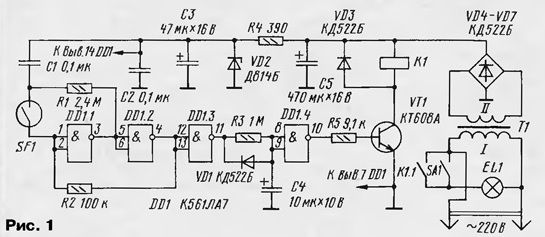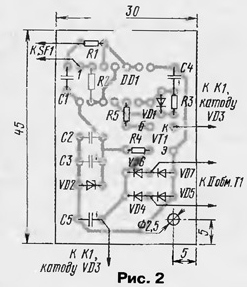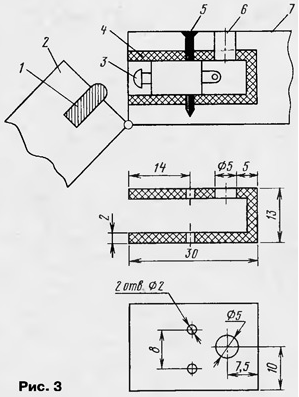It's no secret that at times we forget to switch off the light, say, in the bathroom either in the back room, and it is useless burning for hours. In order to save electricity is desirable to equip the room circuit breaker, protecting him from our carelessness. Then when you enter the room the light will be to ignite, and when the output is off. The machine is connected in parallel available the switch that you have to use at the time of cleaning.
The machine can be performed according to the description in [1], but I'm using the suggested the idea has developed its own version of the design (Fig. 1), which has for years working in my apartment.

Works machine. When you connect it to the network at the output of the counting trigger, performed on the elements DD1.1, DD1.2 [2], a logic low appears level, and the output of inverter DD1.3 - high. Thanks to integrating the chain R3C4 this level is transmitted to the input of the inverter DD1.4 only about seven seconds. All this time is included relay K1, which their contacts K1.1 energizes the lamp EL1, and it burns. Once at the inputs of the inverter there is a high level, lighting the lamp goes out. The machine is ready for operation.
Sensor machine is a reed switch (sealed contact) with trailing SF1 contacts mounted on the upper part of the door frame vertically. Opposite the reed switch must be a permanent magnet, and between them to enter steel area fixed on the door. While the door is closed, the reed switch contacts are open, the machine is in standby mode.
As soon as the door open and enter the room, the corner moves to the side, the contacts of the reed switch are closed. "Works" counting trigger, its output there is a high level, which is inverted by the element DD1.3. The output this element appears a low level, whereby the charged earlier the capacitor C4 is rapidly discharged through the diode VD1 and the output circuits of the element DD1.3. In the end, at the input of the inverter DD1.4 - low level, and the output is high. Opens the VT1 transistor, relay, lighting lamp flashes.
When the door is closed steel area overlaps the magnetic flux, contacts the reed switch opens, but the trigger status is not changed.
When the door open again and out of the room, closing the contacts the reed switch changes the state of the trigger to the opposite. As a result, the transistor is closed, the relay is released, the light goes out. If you need to engage in some work indoors, for example, cleaning, light light switch SA1, automation does not work (i.e. it works in practice, but has no effect on lighting the lamp).
The details of the machine. Reed - any of a series of CAM n / o or change-over contacts. The capacitor C4 is low leakage current, for example, K53-14; C3, C5 - K50-16, K50-35; C1, C2 - km-5, km-6. Diodes VD1, VD3 - any of the series KD521, KD522, Zener diode VD2 - any voltage stabilization 8...10 V. the Transistor is any of the series CT, CT or CTA, CTB. Relay - operating current up to 40 mA at a voltage of not more than 12 In, for example, RES-passport RF4 32.500.335-01. The relay contacts shall withstand a voltage of 220 V and a current of an incandescent lamp. Transformer - industrial or homemade with a voltage in the secondary winding 9...10 V with a load current of at least 50 mA.
Most of the parts mounted on the circuit Board (Fig. 2) of one-sided foil fiberglass. Charge the rest of the details, except for the reed switch, come in a plastic casing of suitable dimensions, and the case is fixed on the the wall near the door.

In the absence of the reed switch is permissible to use the dip switch 3 (Fig. 3), installed inside the bracket 4, to which hollow out a groove in the door frame 7. The microswitch fixing screws (or nails) 5, and the conductors from him withdrawn through the opening 6. Doors have 2 pusher 1 such length that when the door is closed it is securely pressed the button of the microswitch.

Literature
Author: E. Zuev, S. Dentino Vladimir region.






